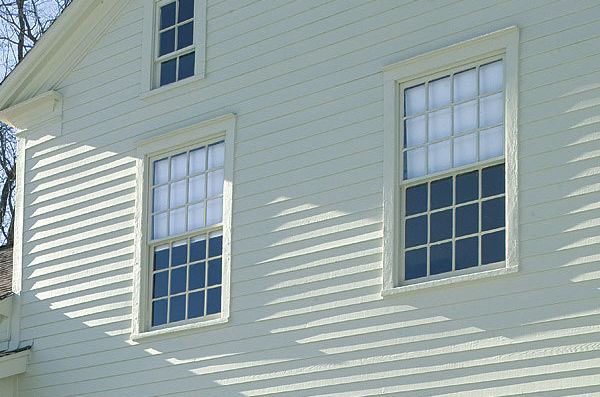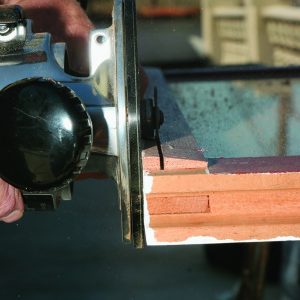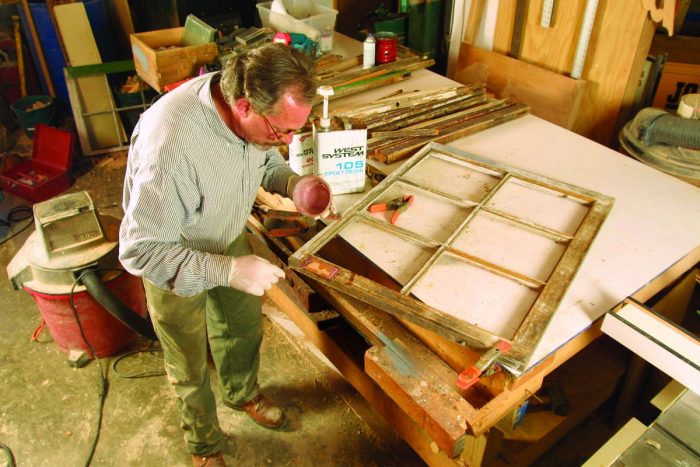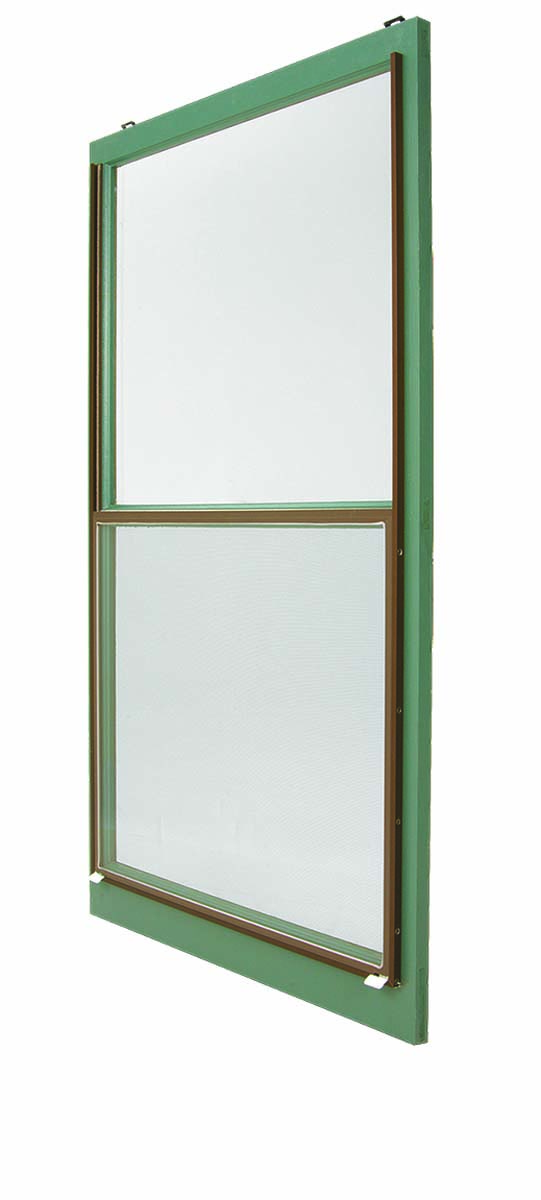Should Your Old Wood Windows Be Saved?
We weigh the options with cost, complexity, efficiency, and preservation in mind.

Synopsis: For many homeowners looking to improve the energy efficiency of a house, one of the first things considered is the windows. Old windows can have lots of drawbacks: broken glass, poorly operating sashes, wood damage, worn jambs. The big question then becomes whether to replace or to repair the old windows. Although replacements could be the right answer, don’t discount the idea of repair, according to FHB associate editor Rob Yagid. Replacement windows can have an extremely prolonged payback period. Old wood windows, however, were built to be repairable. An illustrated problem-and-solution guide will help you to determine your best option.
Old wood windows are as charming as they are maddening. While they offer appealing craftsmanship and an authentic sense of home, they typically leak like a sieve. With rising fuel costs, an unstable economy, and a catatonic housing market, it’s simply becoming more and more difficult to look at those old units with pride.
If you live in a historic district, you may not have the option of installing replacement windows. If you live elsewhere, however, you may be tempted to ditch the whole preservationist mentality and hop on the vinyl replacement train in hopes of reaping all the green rewards and cash savings of a modern home. Don’t – not without carefully considering your options first.
By assessing your existing wood windows and making the right upgrades, you might be able to restore them to rival the performance of a standard replacement at a fraction of the cost.
Consider the potential of your existing windows
You might make a window-replacement contractor’s head spin if you tell him that you’re going to repair rather than replace an old, drafty wood window. After all, thanks to progress in building technology, tight windows with astonishingly high insulating values – Serious Windows, for example (www.seriouswindows.com) – are now available. But not every advanced building solution or product makes sense for everyone. For many, repair work is a desirable alternative to replacement.
In a collaborative effort, the Vermont Energy Investment Corporation, the University of Vermont’s Department of Civil and Environmental Engineering, and the U.S. Army Cold Regions Research and Engineering Laboratory set out to test the value in wood-window repair. In their 1996 paper, “Testing the Energy Performance of Wood Windows in Cold Climates,” they assessed the performance gains accrued through various wood-window upgrades, including the addition of storm windows. Through testing and modelling over 150 windows across the state of Vermont, they found that the difference in annual energy savings between a properly restored wood window and a typical replacement unit amounted to only a few dollars.
The findings that were published in that paper are still supported by experts researching the issue. Michael Blasnik, an independent consultant for over 25 years specializing in energy efficiency, building science, and weatherization-program evaluation, has looked more recently at the energy impact of replacement windows. “The numbers just aren’t as high as you would hope to see,” he explains. “There is actually little data that supports the idea that replacement windows save any significant amount of energy in typical homes.”
Blasnik studied the energy bills of a small sampling of houses in Upstate New York. He looked at their energy bills before and after replacement windows were installed. No other building improvements were made. The findings were less than impressive. On average, the homeowners saved about $40 on their annual heating bills. Consider the expense of replacing all the windows in a house, which could cost as much as $10,000, and replacement hardly seems sensible or economical. By dividing the total investment by the annual energy savings, you get a shocking payback period: The owners of these Northern homes won’t see net cost savings for another 250 years.
Other experts agree. Jim Bunting, senior adviser with Canam Building Envelope Specialists— an Ontario-based firm that has focused on the energy efficiency, health, and durability of homes for 25 years—has reported on window repair: “As windows age, there will come a time when window replacement becomes a preferred option, driven by aesthetic, functional, and property value considerations. The payback from energy savings will, however, be much longer than with repair.” His prediction? “[Repair] can be carried out with relative ease and low cost. Combine this with potential energy savings and the forecast has to be for more repairs than replacements in the future.”

What window manufacturers say
Manufacturers often stress the energy-saving value of replacement windows. The purported savings vary by manufacturer but range from a 15% to a nearly 50% reduction in heating and cooling costs. While window replacement certainly makes sense in a lot of applications—for example, when sloppy window installation contributes to rotting walls or when a homeowner wants the luxury of easy-to-clean modern windows—it’s best to look at the numbers carefully and to ask lots of questions.
“We see a reduction in energy cost from 15% to 30% when replacing double-glazed wood windows with our most energy-efficient ZO-E products,” says Chris Schield, brand manager for Weather Shield Windows. According to Schield, those numbers are calculated with modeling software, though he couldn’t say if the baseline wood window was airtight or had a storm window attached to it. And while a $1500 federal tax credit for installing new energy-efficient windows will help to decrease the payback period of replacements, Schield recognizes that “payback periods can be lengthy.”
Brian Hedlund, a product manager at Jeld-Wen, suggests looking at factors besides energy savings when considering payback periods. “It’s important to look at the impact window replacements have on the value of the home and its comfort,” Hedlund says. “It’s difficult to put a definite price tag on those things, but they do affect the payback period.” Hedlund also says that consumers find comfort in the U-value and solar-heat-gain coefficient (SHGC) ratings applied to replacement windows. “Our customers want guaranteed performance, and a label gives them that satisfaction something you can’t get with old wood windows,” he says.
Jim Krahn, an advanced research manager from Marvin Windows, echoes Hedlund’s viewpoint, but he takes a considerably hard stance about storm windows, stating that “storms, while they improve the insulation rating of windows in many cases, create other issues with egress and [solar heat gain].” When asked about low-e storm windows, Krahn replies, “The low-e glass that is available in storms is based on pyrolytic coatings that have a high SHGC, which does very little to reduce the cooling costs in the South. Code requirements in the South are for SHGC of 0.30 or less. I am not aware of any pyrolytic coatings that will reach that level.”
Assess the existing window to determine the best upgrades
There is good news if your old home still has its original wood windows: They were built to be repaired. According to Jade Mortimer, a window-restoration specialist who operates Heartwood Restoration in Hawley, Mass., “The joinery and construction of old wood windows lends itself to repair.”
Restoring and upgrading old windows isn’t cheap, but much of the expense is paid in sweat if you’re willing to do the work yourself (see “New Life for Old Double-Hung Windows,” FHB #192 and online at FineHomebuilding.com). According to Mortimer, a professional may charge around $200 for a complete restoration and upgrade of each window—maybe more, depending on the damage. However, if you do the work yourself, you can generally expect to pay less than $100 for materials. A storm window can cost as little as $80 or in excess of $300. Again, the upgrade can cost much less if you build your own.
A Problem-and-Solution approach to Restoring Wood Windows
Wood windows built before 1920 were likely made of old-growth lumber, which is more decay resistant and stable than lumber used today. This wood, along with the glass and all the functional parts, can be refurbished. The performance of these old windows and the comfort they provide can be enhanced with storm windows and weatherstripping applied in the right areas.
Problem: A broken sash cord makes window operation difficult, and dangerous for small children.
Solution: Depending on the pulley, you may be able to replace the cord with a sash chain, which is a good option in tough environments, like coastal homes. However, sash cord is relatively inexpensive and perfectly suitable. Don’t use any rope other than sash cord, which typically is braided cotton over a nylon core.
Sources: www.smithrestorationsash.com
Problem: The sashes no longer meet, preventing the lock
from being used. This compromises the seal between the sashes.
Solution: This most likely occurred because the top sash dropped a bit and was painted in place. Free the top sash, and be sure it’s in proper alignment. Chances are the sashes have warped over time, so even with the window locked, the sash won’t seal properly. However, replacing the single lock with two evenly spaced locks will provide even pressure across the sashes and create a better seal.
Sources: www.historichomehardware.com, www.kilianhardware.com

Problem: The large gap between the upper and lower sashes creates an extremely drafty window.
Solution: A length of silicone-bulb weatherstripping placed in a routed groove on the top rail of the bottom sash is one of the easiest fixes to make. It also remains hidden at all times. When the sashes are locked together, the bulb is compressed, creating an airtight seal.
Sources: www.conservationtechnology.com
Problem: A worn jamb creates a window that rattles in the wind, allows air infiltration, and is a pain to operate.
Solution: Small strips of wood can be added to each side of the sash to make up the space between the jambs. An applied V-shaped piece of spring-bronze weatherstripping on the stiles will help to prevent air leakage.
Sources: www.kilianhardware.com
Problem: Broken panes of glass not only create a safety and security issue, but
they also allow air and moisture infiltration.
Solution: Replace the window pane by using simple reglazing techniques (see “Restoring Window Sashes,” FHB #161 and online at FineHomebuilding.com).
Sources: www.bendheim.com

Problem: Air and moisture pour through the gap between the bottom sash and the sill.
Solution: A piece of silicone-bulb weatherstripping inserted in a groove in the bottom rail will seal this critical area.
Source: www.conservationtechnology.com
Problem: Too much paint has rendered the window inoperable.
Solution: Expect to encounter lead-based paint when stripping old windows (see “Lead-Paint Safety, at Home and on the Job,” FHB #150 and online at FineHomebuilding.com). Once the window is completely stripped, repaired, and ready for paint, keep in mind that the pulley, sash cord, jamb, parting bead, and sides of the sash should not be painted.

Problem: The glazing putty has deteriorated, which is adding to the leakiness of the window.
Solution: Remove all the existing putty, and take out the pane of glass out. Clean up all the rabbets, and treat the wood with a conditioner and preservative before reinstalling the glass. As a preservative, Jade Mortimer likes to use a 40/40/20 mixture of boiled linseed oil, Penetrol, and turpentine. Her glazing putty of choice is made by Sarco.
Sources: Sarco Putty (800-969-7889), also available at www.winnmountainrestorations.com

Solution: While some scratches, gouges, and dents can be fixed simply with epoxy and epoxy filler, others demand more extensive repair. A dutchman is a time-tested fix for rotted or otherwise damaged portions of rails and stiles. In other instances, a complete replacement of the part may be necessary. Look for wood that’s the same species and age.
Sources: Mortimer suggests asking a local window-replacement contractor. She finds lots of quality old wood windows in their Dumpsters.
Problem: After all the appropriate upgrades, the windows are still too leaky.
Solution: Install a weatherstripped storm window on the outside of each window. Many old-window owners like single-lite, or one-over-one, storm windows since they offer protection without compromising the look of the home.
Sources: www.spencerworks.com, www.newenglandstorms.com, www.lyonswindow.com, www.alliedwindow.com, www.stormwindows.com







View Comments
It's heartening to see the editor of a magazine geared to DIYers and professionals address this issue.He's dispelling myths spread by window replacement companies about the energy efficiency and durability of their "disposable" windows which have to be replaced AGAIN in 10-20 years. Folks are intimidated by restoration of old windows. But I've seen their "labors of love" be the things are they are most proud in their old home restoration. Thanks, Rob, for taking on the billion dollar companies with the truth.
14 years ago we moved into our 1910 fieldstone carriage house with what looks like Douglas Fir double hung windows, with substantial, beautifully-profiled muntins. Somewhere I found a government study created to compare the cost/benefits of restoring or replacing the windows on old state government buildings that often had 75 to 200 windows. Their conclusion was that because of the payback period with new windows and the lack of ssignificant performance gain, new windows weren't worth it and restoring the existing windows and adding weatherstripping (if they didn't require a lot of repair of the wood frame) was—by far. So, I had them all chemically stripped of the existing paint (the old-growth wood survived this process well) and then I fine sanded and stained them repeatedly until I acheived the deep reddish brown color I was after. Five coats of polyurethane (with some linseed oil mixed in) and rubbing them with 0000 steel wool and they are still gorgeous! Because they probably shrank over time and the sanding, they fit more loosely in the jambs, but the weatherstripping solved that and these windows perform very well with minimal air intrusion. And because of the single pane wiggly glass, I can still hear the birds with the windows closed!